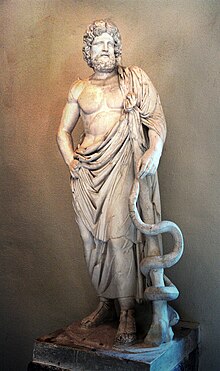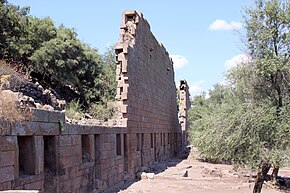
Asclepius with his serpent-entwined staff, Archaeological Museum of Epidaurus
In the ancient era the coastal Yumurtalık district was called Aigai. Today you still may find the small city as a Mediterranean port at a distance of about 40 km (25 mi) from Adana city in Adana Province of Turkey. Aegae is mentioned by both Herodotus and Strabo as being a member of the Aeolian dodecapolis. It was also an important sanctuary of Apollo. Aigai had its brightest period under the Attalid dynasty, a Hellenistic dynasty that ruled the city of Pergamon after the death of Lysimachus, a general of Alexander the Great, which ruled from nearby Pergamon in the 3rd and 2nd century BCE, and lasted from 323–30 bce.
The port has a long history, at least to 2000 bce. Hittite pottery of the 17th century bce has been found in the mound of Zeytinbeli Höyük.
 In the era of the Roman Empire Adana had a naval base and was also a famous place for Asclepius (Greek Asklepios, Latin Aesculapius) the Greco-Roman god of medicine. As son of Apollo (god of healing, truth, and prophecy) and the mortal princess Coronis he shared with Apollo the epithet Paean (“the Healer”) and as such could perhaps keep people eternally healthy or could revive the dead. For this reason Zeus (the king of the gods) who was afraid that Asclepius might render all men immortal slew him with a thunderbolt.
In the era of the Roman Empire Adana had a naval base and was also a famous place for Asclepius (Greek Asklepios, Latin Aesculapius) the Greco-Roman god of medicine. As son of Apollo (god of healing, truth, and prophecy) and the mortal princess Coronis he shared with Apollo the epithet Paean (“the Healer”) and as such could perhaps keep people eternally healthy or could revive the dead. For this reason Zeus (the king of the gods) who was afraid that Asclepius might render all men immortal slew him with a thunderbolt.

Aigai, also Aigaiai, city and bishopric in Aeolis; Facade of Aigai’s market hall
One of three big Asclepius temples of the ancient world can be found in the ancient Greek city of Aigai (Aegae or Aigaiai).
The whole region is rich in historical tissue, and previously there has been found a mosaic depicting the god of love, Eros.
The depiction in the southeastern part of the mosaic has been completely destroyed while the depiction in the north shows Poseidon carrying a trident. There are dolphins in the right and left of Poseidon. When the excavations are completed around the mosaic, the depiction will be meaningful. We believe it dates back to the 3rd or 4th century AD.,
 |
| Mosaic depicting the Greek god Poseidon from the ancient Greek city of Aigai [Credit: AA] |
Like in many other ancient cities, mosaics of Asclepius and Poseidon were placed in bath houses, in the rest areas as well in the massage halls. Poseidon, the god of the sea and protector of all waters was also the protector of many Hellenic cities.
Currently, archaeological research carried out in four regions, uncovered mosaics on the side of the Aegean and Cilicia. The Poseidon mosaic was found in the frigidarium (large cold pool of a Roman bath) part of the ancient bath at the ancient city of Aigai, which is a 1st degree archaeological site. The bottom part of the mosaic contains partly ruined writing in Greek:
“Greetings to all of you bathing.”

+++
Further reading
- Poseidon mosaic discovered in central Turkey
- Poseidon mozaiği Adana’da bulundu
- Παντού Ελλάδα: Aνακαλύφθηκε ψηφιδωτό με ελληνική επιγραφή του Ποσειδώνα στην κεντρική Τουρκία
- mythtake episode 11 mythological tour of the solar system 8: neptune/poseidon
- Review: Poseidon of the Ponds
- Why Should You Read Homers’ Odyssey?
- Homers’ Odyssey – Book V
- Homers’ Odyssey – Book IX
- Homers’ Odyssey – Book XI
- Homers’ Odyssey – Book XIII
- Poseidon
- Poseidon fighting Polybotes
- Call of the deep
- Poseidon In The House
- Christians and Muslims
- God of gods (poem by me)
- Story for the gods
- The Second Coming of Olympus
- Mining the myths of Greece
+++







